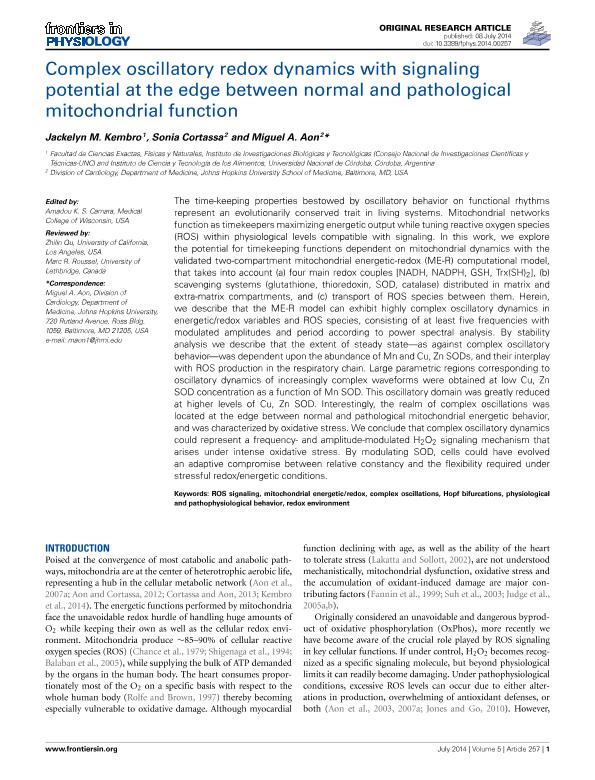Mostrar el registro sencillo del ítem
dc.contributor.author
Kembro, Jackelyn Melissa

dc.contributor.author
Cortassa, Sonia del Carmen

dc.contributor.author
Aon, Miguel A.
dc.date.available
2018-01-03T20:53:17Z
dc.date.issued
2014-06
dc.identifier.citation
Kembro, Jackelyn Melissa; Cortassa, Sonia del Carmen; Aon, Miguel A.; Complex oscillatory redox dynamics with signaling potential at the edge between normal and pathological mitochondrial function; Frontiers; Fronteirs in Physiology; 5; 257; 6-2014; 1-11
dc.identifier.issn
1664-042X
dc.identifier.uri
http://hdl.handle.net/11336/32229
dc.description.abstract
The time-keeping properties bestowed by oscillatory behavior on functional rhythms represent an evolutionarily conserved trait in living systems. Mitochondrial networks function as timekeepers maximizing energetic output while tuning reactive oxygen species (ROS) within physiological levels compatible with signaling. In this work, we explore the potential for timekeeping functions dependent on mitochondrial dynamics with the validated two-compartment mitochondrial energetic-redox (ME-R) computational model, that takes into account (a) four main redox couples [NADH, NADPH, GSH, Trx(SH)2], (b) scavenging systems (glutathione, thioredoxin, SOD, catalase) distributed in matrix and extra-matrix compartments, and (c) transport of ROS species between them. Herein, we describe that the ME-R model can exhibit highly complex oscillatory dynamics in energetic/redox variables and ROS species, consisting of at least five frequencies with modulated amplitudes and period according to power spectral analysis. By stability analysis we describe that the extent of steady state—as against complex oscillatory behavior—was dependent upon the abundance of Mn and Cu, Zn SODs, and their interplay with ROS production in the respiratory chain. Large parametric regions corresponding to oscillatory dynamics of increasingly complex waveforms were obtained at low Cu, Zn SOD concentration as a function of Mn SOD. This oscillatory domain was greatly reduced at higher levels of Cu, Zn SOD. Interestingly, the realm of complex oscillations was located at the edge between normal and pathological mitochondrial energetic behavior, and was characterized by oxidative stress. We conclude that complex oscillatory dynamics could represent a frequency- and amplitude-modulated H2O2 signaling mechanism that arises under intense oxidative stress. By modulating SOD, cells could have evolved an adaptive compromise between relative constancy and the flexibility required under stressful redox/energetic conditions.
dc.format
application/pdf
dc.language.iso
eng
dc.publisher
Frontiers

dc.rights
info:eu-repo/semantics/openAccess
dc.rights.uri
https://creativecommons.org/licenses/by/2.5/ar/
dc.subject
ROS SIGNALING
dc.subject
MITOCHONDRIAL ENERGETIC/REDOX
dc.subject
COMPLEX OSCILLATIONS
dc.subject
HOPF BIFURCATIONS
dc.subject
REDOX ENVIRONMENT
dc.subject.classification
Otras Ciencias Biológicas

dc.subject.classification
Ciencias Biológicas

dc.subject.classification
CIENCIAS NATURALES Y EXACTAS

dc.title
Complex oscillatory redox dynamics with signaling potential at the edge between normal and pathological mitochondrial function
dc.type
info:eu-repo/semantics/article
dc.type
info:ar-repo/semantics/artículo
dc.type
info:eu-repo/semantics/publishedVersion
dc.date.updated
2018-01-03T20:09:13Z
dc.journal.volume
5
dc.journal.number
257
dc.journal.pagination
1-11
dc.journal.pais
Suiza

dc.journal.ciudad
Lausanne
dc.description.fil
Fil: Kembro, Jackelyn Melissa. Consejo Nacional de Investigaciones Científicas y Técnicas. Centro Científico Tecnológico Conicet - Córdoba. Instituto de Investigaciones Biológicas y Tecnológicas. Universidad Nacional de Córdoba. Facultad de Ciencias Exactas, Físicas y Naturales. Instituto de Investigaciones Biológicas y Tecnológicas; Argentina
dc.description.fil
Fil: Cortassa, Sonia del Carmen. University Johns Hopkins; Estados Unidos. Consejo Nacional de Investigaciones Científicas y Técnicas; Argentina
dc.description.fil
Fil: Aon, Miguel A.. University Johns Hopkins; Estados Unidos
dc.journal.title
Fronteirs in Physiology
dc.relation.alternativeid
info:eu-repo/semantics/altIdentifier/doi/http://dx.doi.org/10.3389/fphys.2014.00257
dc.relation.alternativeid
info:eu-repo/semantics/altIdentifier/url/https://www.frontiersin.org/articles/10.3389/fphys.2014.00257/full
Archivos asociados
